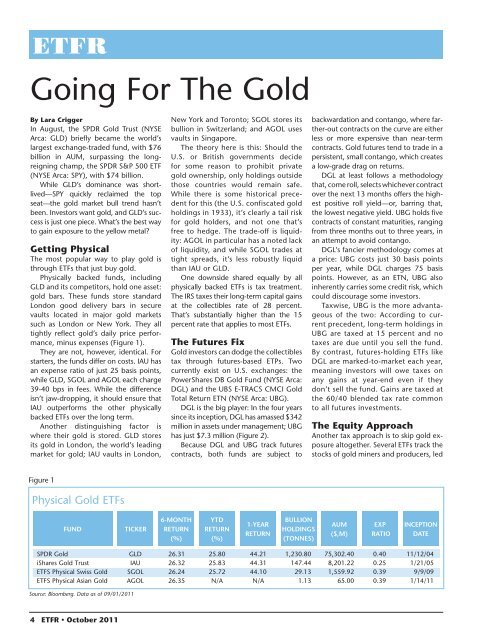Bigger Isn't Always Better - IndexUniverse.com
Bigger Isn't Always Better - IndexUniverse.com
Bigger Isn't Always Better - IndexUniverse.com
You also want an ePaper? Increase the reach of your titles
YUMPU automatically turns print PDFs into web optimized ePapers that Google loves.
Going For The Gold<br />
By Lara Crigger<br />
In August, the SPDR Gold Trust (NYSE<br />
Arca: GLD) briefly became the world’s<br />
largest exchange-traded fund, with $76<br />
billion in AUM, surpassing the longreigning<br />
champ, the SPDR S&P 500 ETF<br />
(NYSE Arca: SPY), with $74 billion.<br />
While GLD’s dominance was shortlived—SPY<br />
quickly reclaimed the top<br />
seat—the gold market bull trend hasn’t<br />
been. Investors want gold, and GLD’s success<br />
is just one piece. What’s the best way<br />
to gain exposure to the yellow metal?<br />
Getting Physical<br />
The most popular way to play gold is<br />
through ETFs that just buy gold.<br />
Physically backed funds, including<br />
GLD and its <strong>com</strong>petitors, hold one asset:<br />
gold bars. These funds store standard<br />
London good delivery bars in secure<br />
vaults located in major gold markets<br />
such as London or New York. They all<br />
tightly reflect gold’s daily price performance,<br />
minus expenses (Figure 1).<br />
They are not, however, identical. For<br />
starters, the funds differ on costs. IAU has<br />
an expense ratio of just 25 basis points,<br />
while GLD, SGOL and AGOL each charge<br />
39-40 bps in fees. While the difference<br />
isn’t jaw-dropping, it should ensure that<br />
IAU outperforms the other physically<br />
backed ETFs over the long term.<br />
Another distinguishing factor is<br />
where their gold is stored. GLD stores<br />
its gold in London, the world’s leading<br />
market for gold; IAU vaults in London,<br />
New York and Toronto; SGOL stores its<br />
bullion in Switzerland; and AGOL uses<br />
vaults in Singapore.<br />
The theory here is this: Should the<br />
U.S. or British governments decide<br />
for some reason to prohibit private<br />
gold ownership, only holdings outside<br />
those countries would remain safe.<br />
While there is some historical precedent<br />
for this (the U.S. confiscated gold<br />
holdings in 1933), it’s clearly a tail risk<br />
for gold holders, and not one that’s<br />
free to hedge. The trade-off is liquidity:<br />
AGOL in particular has a noted lack<br />
of liquidity, and while SGOL trades at<br />
tight spreads, it’s less robustly liquid<br />
than IAU or GLD.<br />
One downside shared equally by all<br />
physically backed ETFs is tax treatment.<br />
The IRS taxes their long-term capital gains<br />
at the collectibles rate of 28 percent.<br />
That’s substantially higher than the 15<br />
percent rate that applies to most ETFs.<br />
The Futures Fix<br />
Gold investors can dodge the collectibles<br />
tax through futures-based ETPs. Two<br />
currently exist on U.S. exchanges: the<br />
PowerShares DB Gold Fund (NYSE Arca:<br />
DGL) and the UBS E-TRACS CMCI Gold<br />
Total Return ETN (NYSE Arca: UBG).<br />
DGL is the big player: In the four years<br />
since its inception, DGL has amassed $342<br />
million in assets under management; UBG<br />
has just $7.3 million (Figure 2).<br />
Because DGL and UBG track futures<br />
contracts, both funds are subject to<br />
backwardation and contango, where farther-out<br />
contracts on the curve are either<br />
less or more expensive than near-term<br />
contracts. Gold futures tend to trade in a<br />
persistent, small contango, which creates<br />
a low-grade drag on returns.<br />
DGL at least follows a methodology<br />
that, <strong>com</strong>e roll, selects whichever contract<br />
over the next 13 months offers the highest<br />
positive roll yield—or, barring that,<br />
the lowest negative yield. UBG holds five<br />
contracts of constant maturities, ranging<br />
from three months out to three years, in<br />
an attempt to avoid contango.<br />
DGL’s fancier methodology <strong>com</strong>es at<br />
a price: UBG costs just 30 basis points<br />
per year, while DGL charges 75 basis<br />
points. However, as an ETN, UBG also<br />
inherently carries some credit risk, which<br />
could discourage some investors.<br />
Taxwise, UBG is the more advantageous<br />
of the two: According to current<br />
precedent, long-term holdings in<br />
UBG are taxed at 15 percent and no<br />
taxes are due until you sell the fund.<br />
By contrast, futures-holding ETFs like<br />
DGL are marked-to-market each year,<br />
meaning investors will owe taxes on<br />
any gains at year-end even if they<br />
don’t sell the fund. Gains are taxed at<br />
the 60/40 blended tax rate <strong>com</strong>mon<br />
to all futures investments.<br />
The Equity Approach<br />
Another tax approach is to skip gold exposure<br />
altogether. Several ETFs track the<br />
stocks of gold miners and producers, led<br />
Figure 1<br />
Physical Gold ETFs<br />
FUND<br />
TICKER<br />
6-MONTH<br />
RETURN<br />
(%)<br />
YTD<br />
RETURN<br />
(%)<br />
1-YEAR<br />
RETURN<br />
BULLION<br />
HOLDINGS<br />
(TONNES)<br />
AUM<br />
($,M)<br />
EXP<br />
RATIO<br />
INCEPTION<br />
DATE<br />
SPDR Gold GLD 26.31 25.80 44.21 1,230.80 75,302.40 0.40 11/12/04<br />
iShares Gold Trust IAU 26.32 25.83 44.31 147.44 8,201.22 0.25 1/21/05<br />
ETFS Physical Swiss Gold SGOL 26.24 25.72 44.10 29.13 1,559.92 0.39 9/9/09<br />
ETFS Physical Asian Gold AGOL 26.35 N/A N/A 1.13 65.00 0.39 1/14/11<br />
Source: Bloomberg. Data as of 09/01/2011<br />
4 ETFR • October 2011
















